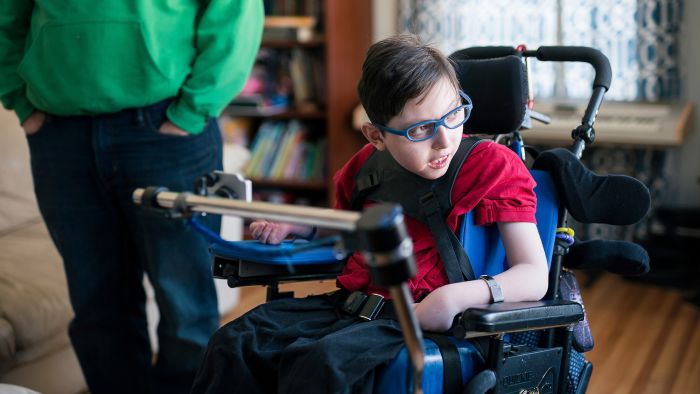Gillette staff have received a new grant from the American Academy of Cerebral Palsy and Developmental Medicine
The American Academy of Cerebral Palsy and Developmental Medicine (AACPDM) awarded a grant to several Gillette Children’s staff to begin investigating muscle quality and function in people who have cerebral palsy (CP) before spasticity treatment to the gastrocnemius. They will use a new technique called an ultrasound-guided microbiopsy in this research. This ongoing study is bolstered by a recently completed pilot study on the same topic.
The Gillette team, led by clinical scientist Liz Boyer, PhD, also includes Gillette physicians Tom Novacheck, MD, and Marshall Taniguchi, MD; two University of Minnesota researchers, Sarah Greising, PhD, and Christiana Raymond-Pope, PhD; as well as a physician mentor from Belgium, Anja van Campenhout, MD, who has previously performed gastrocnemius microbiopsies on children with CP.
The Importance of Maintaining Muscle Quality
Abnormal neuromuscular tone adversely affects function in individuals with CP, prompting many to undergo botulinum toxin injections or selective dorsal rhizotomy (SDR), but animal and human studies have shown that botulinum toxin may cause deleterious effects on muscle size and quality.
Muscle strength is one of the top predictors of gross motor ability and strength is a function of muscle quality, not just size. Therefore, muscle properties should be measured longitudinally in these patients. However, a study of this nature has yet to be done. The Gillette study will begin closing this gap by gathering baseline measures of muscle quality (ultrasonographical, histological, or biochemical) and gross motor function.
“There’s not much literature on pediatric muscle properties, and so often when we are trying to establish if a muscle is healthy or within typical ranges, we can’t really tell, ” Dr. Boyer says. “This study is more rigorously designed, so we can get better answers from better science.”
Researchers' Current Goals
The research funded by the AACPDM grant has two specific aims. First, Dr. van Campenhout provided training for physicians to become proficient in the ultrasound-guided muscle microbiopsy technique.
For the second aim, the team will obtain baseline muscle microbiopsies and functional measures in up to 10 individuals with CP and up to 5 neurotypical controls. By capturing participants’ muscle properties before they undergo intervention, the team will have baseline data for larger longitudinal studies to compare post-intervention muscle quality.
“Because we are finally collecting that baseline, untreated muscle properties and function, we can, with time, determine if treatment is doing something positive, negative, or having no effect on the muscle,” Dr. Boyer says.
The AACPDM-funded research is estimated to be completed in December 2023.
Muscle Biopsy Pilot Study Inspires Future Work
Using generous donations from the Gillette Children’s Foundation, a pilot study paved the way for deeper investigation into muscle properties of individuals who have CP.
Muscle contractures, which can negatively impact gait and function, are a hallmark characteristic of individuals with CP. Treatments (e.g., botulinum toxin, selective dorsal rhizotomy (SDR), musculotendinous lengthening) are often sought to address or prevent these impairments, though studies and Gillette physician experience suggest these treatments do not guarantee prevention of future contractures.
Furthermore, animal and human data suggest that botulinum toxin may cause short- and long-term muscle atrophy, fatty infiltration, and increased fibrosis in these already smaller and functionally impaired muscles. Part of the reason that contractures are hard to prevent thus far may be that the pathogenesis of contractures in CP remains elusive.
The study “Skeletal Muscle Properties After Various Tone Management Approaches in Individuals with Cerebral Palsy” looked at the muscle properties of the gastrocnemius in three children who had undergone different tone management approaches: 1) repeated botulinum toxin injections (BoNT-A), 2) SDR, or 3) no tone management (NO TONE).
The pilot study did not establish causation like the AACPDM-funded study (left) is meant to, but it did provide some clues about potential causal factors of the observed muscle properties. While all three participants had plantarflexor contractures and weakness prior to the biopsy, the largest differences observed between participants were for fiber cross-sectional area, fiber type, lipid content, satellite cell density, and centrally located nuclei. Capillary density, collagen area, and content, and muscle protein content were similar across participants. Several muscle properties appeared to deviate from normative data reported in the literature, though age- and muscle-specific references were sparse.
Join Our Partners in Care Community!
Subscribe to Partners in Care Journal, a newsletter for medical professionals.
Subscribe Today Home Page
Home Page

